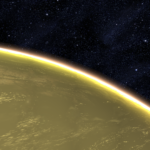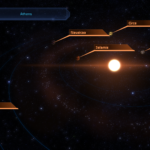System Specs:
- Stellar Mass: N/A Sol Masses
- Stellar Class: N/A
- Luminosity: N/A Sol
- Planets: 5
- Moons: 0
- Asteroid Belts: 1
- Asteroids: 0
- Objects: 0
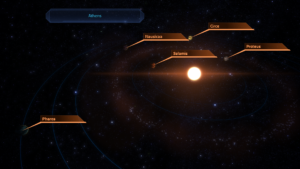
It is probably named for the classical Greek city-state of Athens. All the planets in the system are named after characters and locations associated with ancient Greece and Egypt. Athens is the only system in Mass Effect with no planet to land on or ship to board.
Athens is described as “energetic”.
–
Planets Directory:
- Salamis
- Proteus
- Nausicaa
- Circe
- Pharos
–
Salamis:
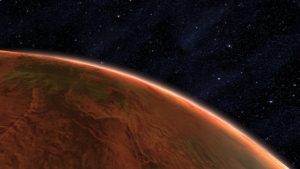
- Orbital Distance: N/A AU
- Orbital Period: 0.4 Earth-years
- Keplerian Ratio: N/A
- Radius: 6,894 km
- Day Length: 58.6 Earth-hours
- Atmospheric Pressure: 1.40 atm
- Surface Temp: 520 °C
- Surface Gravity: 1.3 g
- Mass: 1.508 Earth-masses
The geological properties of Salamis have been scanned from orbit, but little else is known about it. Due to its thick carbon dioxide atmosphere and proximity to the energetic star Athens, the equatorial daytime temperatures have been known to turn the surface molten. The crust is composed of iron with deposits of platinum group metals.
–
Proteus:
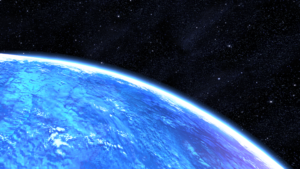
- Orbital Distance: N/A AU
- Orbital Period: 4.9 Earth-years
- Keplerian Ratio: N/A
- Radius: 10,210 km
- Day Length: 51.4 Earth-hours
- Atmospheric Pressure: 1.21 atm
- Surface Temp: 34 °C
- Surface Gravity: 1.3 g
- Mass: 3.307 Earth-masses
- Colony: human
Capital: Ithaka, founded 2179, population 12,470
Like the hanar homeworld, Proteus has more than 90% oceanic cover. The incredible heat thrown off from Athens raises global humidity to 100%, creates constant cloud cover, and powers colossal typhoons that rage across the surface year-round.
Hot, humid, and storm-wracked, Proteus’ rare combination of oxygen-nitrogen atmosphere and carbon-based biosphere nevertheless recommend it for colonization. A pilot program is studying the possibility of colonies below the ocean surface, safe from the worst effects of the weather.
–
Nausicaa:
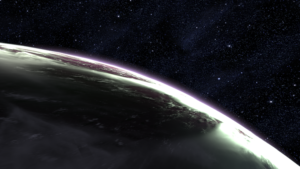
- Orbital Distance: N/A AU
- Orbital Period: 57.6 Earth-years
- Keplerian Ratio: N/A
- Radius: 59,729 km
- Day Length: 14.0 Earth-hours
- Atmospheric Pressure: N/A atm
- Surface Temp: N/A °C
- Surface Gravity: N/A g
- Mass: N/A Earth-masses
Traces of sodium in the atmosphere give Nausicaa its overall dark grey color, but it is otherwise a typical hydrogen-helium gas giant. An abundance of water vapor in the upper atmosphere account for its white clouds.
–
Circe:
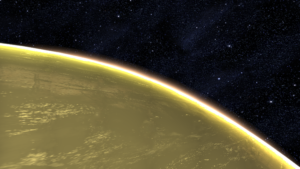
- Orbital Distance: N/A AU
- Orbital Period: 141.9 Earth-years
- Keplerian Ratio: N/A
- Radius: 22,479 km
- Day Length: 10.9 Earth-hours
- Atmospheric Pressure: N/A atm
- Surface Temp: N/A °C
- Surface Gravity: N/A g
- Mass: N/A Earth-masses
Circe is a modestly sized hydrogen-helium gas giant with traces of sulphur and chlorine. These give it its striking yellow-green tint. As the development of the Proteus colony continues, Circe will likely be developed for helium-3 mining.
Circe is too small to be a “hydrogen-helium gas giant” (William Hubbard, The New Solar System 4th ed, 1999; p. 194). It is more likely a dense “ice giant” like Neptune or Gliese 436 b.
–
Pharos:

- Orbital Distance: N/A AU
- Orbital Period: 275.4 Earth-years
- Keplerian Ratio: N/A
- Radius: 7,623 km
- Day Length: 47.4 Earth-hours
- Atmospheric Pressure: 0.04 atm
- Surface Temp: -176 °C
- Surface Gravity: 0.9 g
- Mass: 1.276 Earth-masses
- Satellites: 1
Distant Pharos has seen only a cursory examination by an unmanned probe. It has a trace atmosphere of nitrogen and argon. Its surface is mainly composed of tin with deposits of carbon. Deeper craters have been partly filled by ice, suggesting there may be a significant amount of water locked up beneath its frozen surface. A large, ice-bright crater in the southern hemisphere makes the planet visible from the inner system, leading to the planet’s name.
–
–
video




